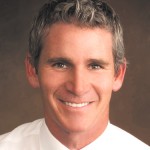Everyday I have new patients come to me with symptoms of pain in their hips and legs. Commonly, these patients have been to orthopedic surgeons or other specialists thinking the pain is stemming from their hip or knee when the problem is really coming from the spine. I’m commonly asked “why is it hurting in my hip or leg if the problem is in my spine”? This is very confusing point for patients and rightfully so. There are two common conditions in the back that cause pain in the hip and leg: spinal stenosis and a herniated disc causing sciatica.
Spinal stenosis is very common. It is not a matter of if you are going to develop spinal stenosis, but when. It is not uncommon for patients to have spinal stenosis by age 40, but usually doesn’t develop until into the 60s or 70s. Stenosis is just a medical term for narrowing. In order for your spinal nerves to reach your legs they must travel through the spinal canal via the spinal cord. Bulging disks, bone spurs, and thickened ligaments around the spinal canal can cause the canal to narrow. This most commonly happens in the lower lumbar spine.
Symptoms of spinal stenosis include low back pain, hip and leg pain. This pain can be on the left or right only but is most often felt on both hips or legs. Pain usually worsens the longer a patient stands or walks and commonly subsides soon after sitting down. This is due to the fact that when one is standing or walking, the narrowed central canal narrows even more. Patients suffering from spinal stenosis commonly give a history of “the Shopping Cart Sign”. Leaning over a shopping cart usually relieves their symptoms. That narrowing tends to open more widely when sitting down or leaning over a cart.
The second most common symptom I hear about in my clinic is a herniated disc causing sciatic pain. This pain radiates down the back into the buttock, knee and occasionally the foot. Whereas spinal stenosis is typically felt in both legs, herniated discs are commonly felt in one leg. Herniated disc sciatic pain typically worsens when sitting for extended periods of time. Sitting puts increased pressure on the disc and causes the disc protrusion to get bigger. The larger protrusion then further narrows the tiny nerve openings on the side of the spinal canal called neuroforamen and irritate the spinal nerve causing sciatic pain.
Ultimately both the pain from the spinal stenosis and herniated discs are treated similarly. A primary care physician or interventional spine specialist help diagnose both conditions. A full history and physical exam should be performed. Sometimes further testing such as x-rays, CT scans, MRIs and nerve conduction studies are needed to confirm the diagnosis. Surgery is usually not required to treat these conditions, unless a significant amount of numbness or weakness is noted on the physical exam. Successful conservative treatments include physical therapy, medications, and x-ray guided (fluoroscopic) epidural steroid injections.
Physical therapists can typically teach patients certain postural changes, pelvic tilting, or other core strengthening exercises that help prevent and minimize the symptoms of spinal stenosis and herniated discs. Anti-inflammatories, corticosteroids, acetaminophen, opiates and non-opiate pain medications as well as neuropathic (anti-convulsant) medications can treat these symptoms as well. Periodic epidural steroid injections are very successful at alleviating this spinal stenosis and sciatic pain. Ultimately, if conservative treatment fails minor surgical treatment is sometimes necessary to relieve the pain. A laminectomy is commonly required for spinal stenosis and a microdiscectomy is typically performed for disc herniation. These are typically considered low risk surgeries and usually done as either an outpatient or a 24-hour hospital stay. Ultimately my goal is to get patients out of pain without surgery.
Finally, if you are having pain that radiates in your back, hip, leg or foot that worsens with extended standing, walking or sitting, you may have spinal stenosis or a herniated disc. With medications, therapy or epidural injections, and hopefully not surgery, we can typically get you better without surgery!
Dr. Court Empey is a board certified interventional pain and spine specialist and founder of Desert Pain Specialists in St. George, Utah. (435) 216-7000.
